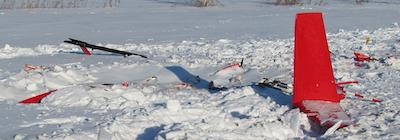Wed, Feb 20, 2019
Collision With Terrain Involving A Helicopter In Saint-Joachim-De-Courval, Quebec, Demonstrates The Risks Associated With Insufficient Recent Experience In Instrument Flight
In its investigation report (A18Q0016) released Monday, the Transportation Safety Board of Canada (TSB) underscored the risks posed by insufficient recent experience flying with reference to instruments, particularly in the case of night flights when unfavourable weather conditions are encountered and pilots lose visual reference to the ground.

On 01 February 2018, at about 1945 Eastern Standard Time, a privately operated Robinson R44 Raven I helicopter departed Saint-Georges de Beauce, Quebec, with the pilot and 2 passengers on board, on a night visual flight rules (VFR) flight to Saint-Alexis-de-Montcalm, Quebec. At 2032, the Canadian Mission Control Centre received a distress signal from the helicopter's emergency locator transmitter. At about 2135, the helicopter was found in a field in Saint-Joachim-de-Courval, near Drummondville. The helicopter was destroyed by the impact forces and a post-impact fire. All of the occupants were fatally injured.
The investigation determined that it is highly likely that the pilot encountered unfavourable weather conditions which led to a loss of visual references to the ground, and that he lost control of the helicopter as a result of spatial disorientation. Although the pilot held a valid pilot licence and a night rating, it is likely that, given his training and limited night flight experience, he did not have the necessary skills to handle a significant reduction in visual references to the ground.
The investigation highlighted several risk factors associated with night VFR flights. If pilots are not required by the Canadian Aviation Regulations (CARs) to maintain their instrument flying skills in order to use the privileges of a night rating, there is a risk that they will be unable to recognize spatial disorientation and react appropriately, increasing the risk of an accident resulting from a loss of control. Furthermore, if the CARs do not require pilots who conduct night VFR flights to undergo recurrent assessments in the form of dual instrument flights with a qualified instructor, there is an increased risk that, in the event of a loss of visual references, pilots may not be able to maintain control of the aircraft or to regain control in time to avoid an accident.
(Image provided with TSB news release)
More News
Aero Linx: The International Civil Aviation Organization (ICAO) The International Civil Aviation Organization (ICAO) is a United Nations agency which helps 193 countries to coopera>[...]
About 25 Days (9.3 Hours) Before The Accident, The Airframe Was Modified With Different Landing Gear Legs, Wheels, And Brakes Analysis: The pilot reported that during the landing r>[...]
Dave Juwel's Aviation Marketing Stories ITBOA BNITBOB ... what does that mean? It's not gibberish, it's a lengthy acronym for "In The Business Of Aviation ... But Not In The Busine>[...]
“Over 2025, Vertical has shown that when we set targets, we deliver. Whilst maintaining our industry-leading capital efficiency, we are not only demonstrating all piloted fli>[...]
Aero Linx: Air Medical Physician Association (AMPA) The Air Medical Physician Association (AMPA) is the largest professional organization of physicians dedicated to rotor wing (hel>[...]
 ANN's Daily Aero-Linx (11.06.25)
ANN's Daily Aero-Linx (11.06.25) NTSB Final Report: Champion 7GC
NTSB Final Report: Champion 7GC Aero-FAQ: Dave Juwel's Aviation Marketing Stories -- ITBOA BNITBOB
Aero-FAQ: Dave Juwel's Aviation Marketing Stories -- ITBOA BNITBOB Aero-News: Quote of the Day (11.06.25)
Aero-News: Quote of the Day (11.06.25) ANN's Daily Aero-Linx (11.06.25)
ANN's Daily Aero-Linx (11.06.25)



